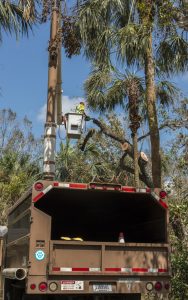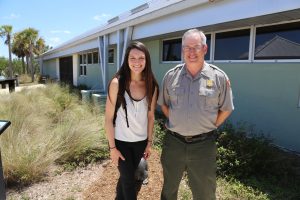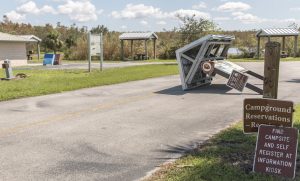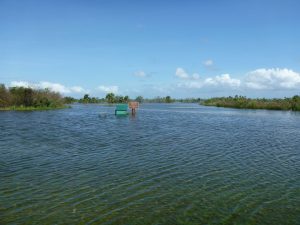
Hurricane leaves mark on Big Cypress
OCHOPEE, Fla. —Sept. 10, 2017, was the dreadful day that Hurricane Irma made landfall in South Florida. It is seven months since the hurricane, but its unexpected route through Florida and the damage that came with it are impossible to forget. One of the many areas that were affected was Big Cypress National Preserve, located 50 miles east from Naples and 80 miles west from Miami.
Created in 1974 by Congress, Big Cypress is a 729,000-acre national preserve encompassing the Big Cypress Swamp that flows water to the Everglades and many other islands. The fresh water flowing through the preserve feeds a variety of five different habitats, like hardwood hammocks, pinelands, prairies, cypress swamps, and is vital for the health of the estuaries in Southwest Florida and for the Gulf of Mexico.
 |
The National Park Service’s Arborist Incident Response Team removes fallen trees after Hurricane Irma (Photo courtesy of National Park Service, Eastern Incident Management Team). |
Big Cypress has mild, yet tropical, plant communities that are essential to a variety of wildlife, like alligators and the mysterious Florida panther that is said to be roaming within the national preserve.
Visitors can engage in a myriad of activities while at the preserve, such as camping, kayaking, hiking, canoeing, birding, wild flower viewing, bicycling, hunting and off-road vehicle exploration. But when Hurricane Irma hit the area with its powerful winds and incessant rain, avid Big Cypress staff and visitors could not lead or participate in any of these activities, as the national preserve had undergone significant damage resulting from the hurricane.
David True, a park ranger at Big Cypress, recalled that the damage from Hurricane Irma was extensive enough to force Big Cypress to close in order to focus on restoration and added that the park staff also needed support.
| David True, a park ranger at Big Cypress National Preserve, and reporter Amanda Torres at the Big Cypress Swamp Welcome Center (Photo courtesy of Amanda Torres). |  |
“Due to mildew, mold, water underneath our Big Cypress Swamp Welcome Center and more, Big Cypress did not open until about a month after the hurricane,” True said. “Our park staff also lost their homes and possessions, mostly the park staff that lived in Naples.”
Besides the damages that True shared, there were also damages ranging from utility outages, a boil water advisory, fuel shortages to damaged roofs at a maintenance building and ranger station, flooding, downed power lines, signs and trees. Big Cypress had big clean-up in its future before reopening to the public.
Ardrianna McLane, public affairs officer for the preserve, elaborated more on these damages.
“Immediately after the storm, roadways and utility systems were inundated with surface water. Many roadways were closed to prevent vehicle damage to asphalt surfaces and safety impacts to the public. Power, cell phone and widespread utility outages throughout the local area resulted in closed facilities and a month-long preserve closure,” McLane said. “Wind damage and rain intrusion resulted in 20 facility locations with moderate to severe mold impacts. Extensive mold remediation, repair and testing have resulted in over 100 percent of the impacted facilities recovering to date. The high-water levels associated with the rainfall from the storm delayed opening some areas, like recreational hunting.”
 |
Damage caused by the hurricane (Photo courtesy of National Park Service, Eastern Incident Management Team). |
Crews from the National Park Service areas helped work together as incident management teams. The National Park Service also asked for a Type 1 Incident Command Team after the hurricane, which are first responders who are adequately trained, specialists and experts in facilities and resources. Even local park employees voluntarily extended their help, despite their own hardship with the loss of their homes and possessions.
Don Finefrock, executive director at South Florida National Parks Trust, shared details on how SFNPT supported the park staff during this difficult time.
“The SFNPT worked with the Community Foundation of Collier County to make disaster relief grants to park service employees at Big Cypress whose homes or personal property was damaged by the storm,” Finefrock said. “Seventeen employees applied for funding and each received disaster recovery. Approximately $16,000 went to provide disaster relief for Big Cypress employees. Some employees are still struggling with the aftermath of the storm, but the disaster relief allowed them to get back on their feet by providing immediate assistance with minimum red tape.”
Finefrock added that providing relief and recovery efforts was possible because the Community Foundation agreed to set forth the fund, who had hosted and administered a similar fund in the past. All of the donors, Finefrock said, “were private donors; no government funding was involved.”
The National Parks Conservation Association also set up a page that read, “Ask Congress to Provide Hurricane Relief for National Parks and Park Communities.” This was posted after the hurricane in hopes to get funding to make national parks and preserves more resilient to future hurricanes.
McLane shared that NPS provided much support to the park staff, too, by establishing a tracking system and provided immediate aid as needed.
“The NPS was focused on the safety and well-being of our staff. We established an emergency check-in number to make sure that they were all located, safe, and could establish what they might need for support,” McLane said on behalf of NPS. “Initially, the goal was to find everyone and then begin the process of helping to direct them to recovery resources and emergency assistance. Many staff volunteered on their own time to help tarp each other’s roofs, bring over fuel and water, and work together. For the management, severe weather team, and ICS group, they worked hard to bring in first responders to help staff with support. The South Florida National Parks Trust and Eastern National set up mini-grants to help staff make it through the initial stages of emergency leave.”
| Flooding at Big Cypress after Hurricane Irma (Photo courtesy of National Park Service, Eastern Incident Management Team). |  |
The help of volunteers, whether from the national preserves’ own staff, or avid visitors, are an integral part of national parks and preserves, but especially during a hurricane season and the recovery and restoration process.
Raquel Martinez, an environmental and sustainability studies student at Florida International University, frequents Big Cypress whenever she has a chance and was at a loss for words when she saw pictures of Big Cypress following the hurricane.
“It deeply saddens me to see these images. I hope that with the incredible team of staff members and the support of all those who frequent the preserve may recover from these damages quickly, if they have not already done so,” Martinez said. “I would most certainly love to participate in any future restoration initiatives that take place in our national parks or preserves. Given the nature of this year’s predicted active hurricane season, I am ready to jump into action if any restoration efforts are necessary in the area.”
Finefrock added that, “Volunteers make a huge difference year-round in South Florida’s national parks, but that’s especially true in the aftermath of a storm like Irma when the parks are struggling to clear debris, remove hazards and restore order before reopening to the public. Hundreds of national park volunteers signed up to help in South Florida after the storm and we were able to match them with specific jobs and work days in the parks.”
Perusing through Big Cypress now, it is hard to imagine that a serene-like place would have gone through such damages. But there are still improvements to be made.
“Currently, extensive roof damage remains tarped while many other areas have been temporarily patched and are awaiting more permanent repairs,” according to McLane.
With another hurricane season approaching, let’s hope it is not as damaging as the hurricane season in 2017.
If you would like to volunteer at Big Cypress National Preserve, please fill out an application here.
If You Go
- Addresses:
- Big Cypress National Preserve, Oasis Visitor Center, 52105 Tamiami Trail East, Ochopee, Fla. 34141, 239-695-1201.
- Big Cypress Swamp Welcome Center, 33000 Tamiami Trail East, Ochopee, Fla. 34141, 239-695-4757.
- Big Cypress National Preserve headquarters, 33100 Tamiami Trail East, Ochopee, Fla. 34141, 239-695-1103.
- Directions: Visitors can access Big Cypress from Miami and Naples. The preserve is located on the Tamiami Trail East and I-75 in South Florida. Click here for more detailed directions.
- Operating Hours: Big Cypress is open 24 hours a day. But the Oasis Visitor Center and the Welcome Center are open from 9 a.m. – 4:30 p.m., Monday through Sunday. The visitor centers are closed on Dec. 25.
- Weather: Two major seasons: wet and dry. The rainy season is from May through Oct, consisting of reoccurring thunderstorms, humidity, lots of mosquitoes and temperatures in the 80s. Dry season is from November through April. Come during this time if you wish to hike, camp or admire the wildlife, as the conditions are ideal to do so. For more thorough details, click here.
- Be prepared: travel green, goods and services, pets and stay safe, especially in remote areas with no cell phone coverage.

Comments are Closed